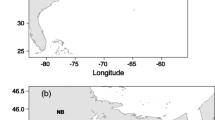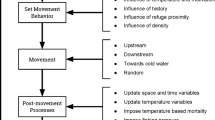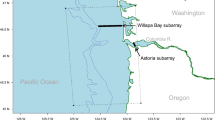Abstract
General response patterns of fish populations tostress, originally proposed by Colby for fisheriesrehabilitation and later adapted by Munkittrick forcontaminants, were evaluated using an individual-basedsimulation model. General response patterns relatechanges in population-level variables to the type ofstress. The model follows the daily growth,mortality, and spawning of individual yellow perch andwalleye through their lifetime, and was corroboratedusing Oneida Lake data. Two versions of the model wereused: population (yellow perch only) and community(dynamic predation on yellow perch by walleye). Eightstresses were imposed on the population and communityversions of the model and 100-year simulations wereperformed. Response patterns were defined by changesin predicted yellow perch mean population abundance,mean age of adults, and mean adult growth (representedby mean length at age-7). Proposed response patternswere similar to those predicted using the populationversion of the model. Simulations using the communityversion of the model distorted the response patterns,either causing amplification, dampening, or reversalof many of the patterns. Predicted response patternsbecame unique when additional variables were included.Our model results suggest that caution is appropriatein interpreting general response patterns based onmean age, or when the population of interest plays amajor role in a relatively simple food web. The responsepattern approach may be better at identifying the lifestage impacted rather than the mechanism of the stress.
Similar content being viewed by others
References
Adams, S.M., J.S. Jaworska & K.D. Ham, 1996. Influence of ecological factors on the relationship between MFO induction and fish growth: bridging the gap using neural networks. Mar. Environ. Res. 42: 197–201.
Colby P.J., 1984. Appraising the status of fisheries: rehabilitation techniques. In: V.W. Cairns, P.V. Hodson & J.O. Nriagu (eds), Contaminant Effects on Fisheries. Adv. Environ. Sci. Tech. 16: 233–257.
EC/DFO (Environment Canada and Department of Fisheries and Oceans). 1995. Further guidance for the adult fish survey for aquatic environmental effectsmonitoring related to federal Fisheries Act requirements. EEM 1. Environment Canada, Ottawa, Ont., 72 pp.
EC/DFO (Environment Canada and Department of Fisheries and Oceans). 1993. Technical guidance document for aquatic environmental effects monitoring related to federal Fisheries Act requirements. Environment Canada, Ottawa, Ontario, Version 1.0., 128 pp.
Forney, J.L., 1980. Evolution of a management strategy for the walleye in Oneida Lake, New York. NY Fish Game J. 27: 105–141.
Gibbons, W.N. & K.R. Munkittrick, 1994. A sentinel monitoring framework for identifying fish population responses to industrial discharges. J. Aquat. Eco. Health 3: 227–237.
McCarthy J. & L.R. Shugart, 1990. Biomarkers of Environmental Contamination. Lewis Publishers, CRC Press, Boca Raton, FL.
Mills, E.L. & J.L. Forney, 1988. Trophic dynamics and development of freshwater pelagic food webs. In: S.R. Carpenter (ed), Complex Interactions in Lake Communities. Springer-Verlag, New York, NY, pp. 11–30.
Mills, E.L., J.L. Forney & K.J. Wagner, 1987. Fish predation and its cascading effect on the Oneida Lake food chain. In: W.C. Kerfoot & A. Sih (eds), Predation: Direct and Indirect Impacts on Aquatic Communities. University Press of New England, Hanover, NH, pp. 118–131.
Munkittrick, K.R. & D.G. Dixon, 1989a. Use of white sucker (Catostomus commersoni) populations to assess the health of aquatic ecosystems exposed to low-level contaminant stress. Can. J. Fish. Aquat. Sci. 46: 1455–1462.
Munkittrick, K.R. & D.G. Dixon, 1989b. A holistic approach to ecosystem health assessment using fish population characteristics. Hydrobiologia 188/189: 123–135.
Munkittrick, K.R. & L.S. McCarty, 1995. An integrated approach to aquatic ecosystem health: top-down, bottom-up, or middle-out? J. Aquat. Eco. Health 4: 77–90.
Rose, K.A., E.S. Rutherford, D.S. McDermot, J.L. Forney & E.L. Mills, (in review). An individual-based model analysis of wall-eye and yellow perch population dynamics in Oneida Lake. Ecol. Monogra.
Rothshild, B.J., 1986. Dynamics of Marine Fish Populations. Harvard University Press, Cambridge, MA.
Thorpe, J., 1977. Synopsis of biological data on the perch Perca fluviatilis Linnaeus, 1758 and Perca flavescensMitchill, 1814. FAO Fisheries Synopsis No. 113, Food and Agricultural Organization of the United Nations, Rome, Italy.
Winemiller, K.O. & K.A. Rose, 1992. Patterns of life-history diversification in North American fishes: implications for population regulation. Can. J. Fish. Aquat. Sci. 49: 2196–2218.
Author information
Authors and Affiliations
Rights and permissions
About this article
Cite this article
Jaworska, J.S., Rose, K.A. & Barnthouse, L.W. General response patterns of fish populations to stress: an evaluation using an individual-based simulation model. Journal of Aquatic Ecosystem Stress and Recovery 6, 15–31 (1997). https://doi.org/10.1023/A:1008280503843
Issue Date:
DOI: https://doi.org/10.1023/A:1008280503843




